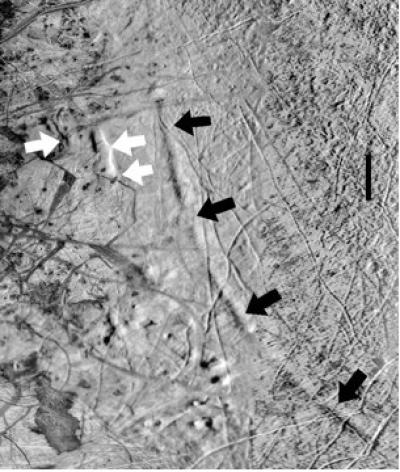Curved features on Jupiter’s moon Europa may indicate that its poles have wandered by almost 90°, a new study reports. Researchers believe the drastic shift in Europa’s rotational axis was likely a result of the build-up of thick ice at the poles. “A spinning body is most stable with its mass farthest from its spin axis,” says Isamu Matsuyama of the Carnegie Institution’s Department of Terrestrial Magnetism. “On Europa, variations in the thickness of its outer shell caused a mass imbalance, so the rotation axis reoriented to a new stable state” An extreme shift like this also suggests the existence of an internal liquid ocean beneath the icy crust.
The research team, led by Dr. Paul Schenk of the Lunar and Planetary Institute and joined by Matsuyama and Dr. Francis Nimmo of the University of California, Santa Cruz, used images from the Voyager, Galileo, and New Horizons spacecraft to map several large arc-shaped depressions that extend more than 500 kilometers across Europa’s surface. With a radius of about 1500 kilometers, Europa is slightly smaller than the Earth’s moon.
By comparing the pattern of the depressions with fractures that would result from stresses caused by a shift in Europa’s rotational axis, the researchers determined that the axis had shifted by approximately 80°. The previous axis of rotation is now located about 10° from the present equator.
Such a change is called “true polar wander” as opposed to apparent polar wander caused by plate tectonics. There is evidence for true polar wander on Earth, and also on Mars and on Saturn’s moon Enceladus. “Our study adds Europa to this list,” says Matsuyama. “It suggests that planetary bodies might be more prone to reorientation than we thought.”
The study also has implications for liquid water inside Europa. Many scientists believe Europa has an extensive subsurface ocean based on spacecraft photos showing a fractured, icy surface. The ocean beneath the crust would be kept liquid by heat generated by tidal forces from Jupiter’s gravity. The presence of heat and water may make life possible, even though the subsurface ocean is cut off from solar energy.
“The large reorientation on Europa required to explain the circular depressions implies that its outer ice shell is decoupled from the core by a liquid layer,” says Matsuyama. “Therefore, our study provides an independent test for the presence of an interior liquid layer.”
Original News Source: EurekAlert


If this is 100% true, this provides some very conclusive evidence that Europa is indeed sitting on top on an ocean. If the ice is able to shift the axis of the planet, it proves that
1. Liquid water is indeed under the surface
2. That the ice is less dense in places that the poles
3. There is sufficient heat to generate tempertaures suitable for ocean life to evolve, potentially more than just bacteria around thermal vents, providing they don’t need sunlight
God I love Europa. I can’t wait until we send a mission there.
Amen Maugrim.
Europa should be top priority.
Will we find life there? Maybe.
Should we look? Without a question.
Oh, I know I havent been saying anything here for awhile, thats due to lack of internet. But great article Nancy 🙂
Europa should be explored in great detail.
I thought we were told to explore any world BUT Europa by the Monolith?
Are all of you insane? You obviously didn’t get the memo:
ALL THESE WORLDS ARE YOURS EXCEPT EUROPA. ATTEMPT NO LANDINGS THERE.
The press Release that was quoted originally was from Carnegie Institute,
which fails to mention either of the other authors!
For a proper treatment and links to the
paper itself, and further information:
http://www.lpi.usra.edu/eatures/europa/cropCircles/
Couldn’t we drop a few seismic probes on Europa to map the interior, to get a better picture of exactly what is under the ice? That might be the first step. Or something like a Europa Reconnaisance Orbiter with radar or gravity mapper. Heck, we could even nuke a small hole in the surface and see if it produces liquid.
Well, if Europa’s crust is indeed completely suspended – couldn’t it then be considered one giant continent? Then we’d be back to apparent polar wander again.
why don’t we just send one of those fish-finders?
this bubble hash is sooo tastey!!